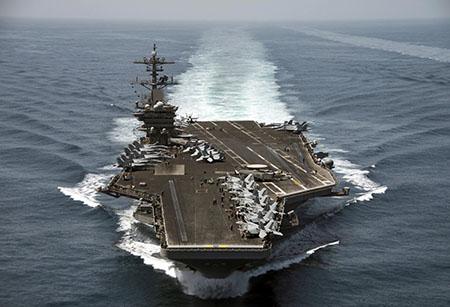If finalized, the United States will find itself without a carrier for one or two months after USS Theodore Roosevelt and its battle group will leave the Middle East.
USS Harry Truman and his carrier battle group will be re-positioned in the Middle East only as of next winter. The absence of the carrier will be filled with the air bases in the region. It is clear, however, that CentCom will not have the same tactical options provided by a carrier and CSG for two months.
.jpg) The US Navy has adopted a new 'deployment' plan for the ten in-service nuclear carriers that aims to reduce the time spent at sea for each individual deployment. There are currently ten super-aircraft carriers in the US Navy fleet.
The US Navy has adopted a new 'deployment' plan for the ten in-service nuclear carriers that aims to reduce the time spent at sea for each individual deployment. There are currently ten super-aircraft carriers in the US Navy fleet.
Due to multiple factors, including continuous maintenance, the Navy is unable to maintain a constant presence in any place where a military commitment is required, especially as the United States is involved in a growing number of operations.
If CentCom were required to make it official to Secretary of Defense Ashton Carter, Roosevelt could continue its presence in the Persian Gulf.
Meanwhile, the US Navy has awarded Huntington Ingalls, a $ X billion billion contract to finalize the design and construction of the USS John F. Kennedy aircraft carrier.
The final cost of the second class aircraft carrier Ford has already exceeded the budget provided by Congress by 370 million dollars. It should be noted that the leader of the new class, the USS Ford, has breached the planned budget of two billion dollars.
.jpg) When it comes to service, the leader of the new class will be the most expensive naval vehicle in history with a total $ 13 $ billion spending.
When it comes to service, the leader of the new class will be the most expensive naval vehicle in history with a total $ 13 $ billion spending.
At the Huntington site Ingalls was simultaneously awarded a contract of 940 thousand dollars for labor and materials that will be needed to complete the construction of the aircraft carrier.
Jobs will be carried out at the Newport News yard in Virginia, and should end by June 2022.
The USS John F. Kennedy (CVN 79) aircraft carrier is designed to have a 50 years of service life. The former USS John F. Kennedy (CV 67) carrier was dropped in the 2007 after almost 40 years of service. Huntington Ingalls is the largest US shipbuilding company in the United States.
The most powerful fleet in the world: yet for how long?
The United States needs time and money to update the entire fleet spread around the world: the problem is that they do not have enough time and money. The prolonged maintenance of the units deployed to support the operations in progress, would be to trigger a cascading effect on the entire fleet that requires implementation and restructuring. Maintenance necessary to guarantee the expected life cycle of the units, but which can not be carried out as planned. The result is that Navy ships may not be able to respond to future threats.
The problem has long been known. Less than half of the warships entered last year in private and public shipyards for repairs and upgrades have returned to the sea, while the Navy budget has already been depleted.
.jpg)
The causes are mainly two. The first is purely logistical. For years the Navy has postponed maintenance and upgrades to keep fleets deployed in support of the wars in Iraq and Afghanistan. The second is an economic one. The Defense cuts, in fact, have led to a block in recruitment in the public shipyards of the Navy. Just to give an example: the Norfolk Naval Shipyard, in Portsmouth, was also forced to limit overtime for civilian employees: this led to a deficit in the workforce.
The Navy's public shipyards work mainly on nuclear-powered aircraft carriers. Delays also in the production of submarines. At least eight boats registered delays ranging from two to nine months. At the beginning of last year, Fleet Forces Command announced an Optimized Fleet Response Plan (Fleet Response Plan), based on an operating cycle of 36 months instead of 32. The new cycle of 36 months begins with a maintenance period followed by a three month basic training phase and a further three months of advanced training. 30 pre-holiday days for the crew in view of the deployment abroad (Pre-Overseas Movement Phase), then an eight-month operational mission.
The rest of the time is known as the subsistence phase of the duration of 14 months: the ship remains ready to intervene in case of emergency. Plan, however, totally subordinated to factors that not even the most powerful Navy in the world can control. In fact, in fact, in addition to the current crisis theaters if others were to be added (and considering the continuous cuts to the Defense), the US Navy would find itself deploying units without replacement or without preventive maintenance (which happens in 40% of the boats at sea).
The carriers will adopt the new 36 plan months within the next four years according to the following forecast: Bush and Carl Vinson starting next year. Truman, Theodore Roosevelt, and Gerald R. Ford in 2016. Lincoln and John C. Stennis in 2017. Finally, Nimitz, by the 2018.
Franco Iacch
.jpg)
.jpg)
(photo: US Navy)












